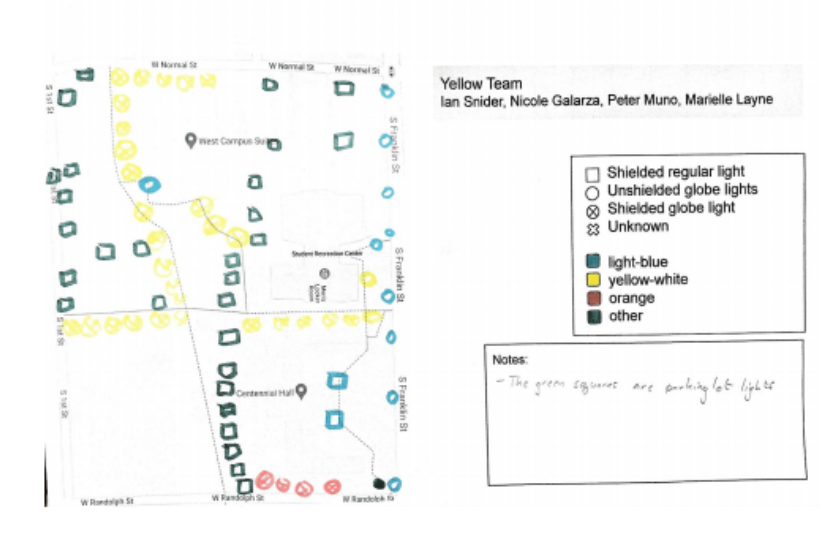Final Projects
Science Team I Final Report
Today we look up in our sky and we do not see any stars, in most places at least you will not see what some of our older ancestors used to see. Even when the sky is clear, the sky is just dark and boring, but why is that and how does it work? This concept is called light pollution, it is
something that is not widely talked about even though it has more environmental effects than just no stars in the sky. Even without an environmental outlook, the past has shown stars to be used for great things, such as travelling the oceans and when Harriet Tubman saved slaves from the South during the Civil War. The problem is how do we fix this issue, and how can we make it simple for everyone to understand and do their part. Continue reading here
Science Team I Final Report II
This semester we dove into light pollution and learned what it is, how we can prevent it, and current issues causing it. After doing some research on light pollution, we learned that light pollution is the brightening of the sky due to unnatural sources of light bouncing off of the Earth and into the sky. The brightness of the sky is called skyglow, which is typically caused by the sunlight bouncing off of the moon and Earth, a low grade aurora in the upper atmosphere, zodiacal light, starlight scattered in the atmosphere, and background light from unresolved stars. Light pollution increases skyglow which makes it more difficult to see the stars at night. Sky brightness is also a key factor and it is what scientists measure to determine the amount of light pollution in a given area. There are many different factors in determining light pollution, including light trespass, clutter, and glare. All of these components are important vocabulary to know when discussing light pollution. Continue reading here
Science Team II Final Report
Throughout this symposium class, we have researched the effects of light pollution on the rest of the ecosystem. The aim of this course is to take steps towards to making Kirksville an International Dark Sky Community, which requires following specific guidelines including: having a specific amount of shielded lights, restricting the amount of unshielded lighting, restricting illuminated signs, limiting the the emission of short-wavelength light, and other light-related regulations. Continue reading here
Science Team II Report II
Although this class may not relate closely to my major, I found it a very interesting topic to learn about. Illuminate was a classed focused on the topic, issues, and solutions of light pollution. Light pollution is the introduction of artificial light into the natural environment. In more simple terms, light pollution is wasted light that performs no function. While it may seem good that we can see more at night, there are numerous negative side effects of light pollution. Continue reading here
Design Team Final Report
My time in TRU 100 ILLUMINATE! has certainly been an enlightening experience in terms of becoming aware of the different facets of light pollution. More specifically, I was previously unaware of how light pollution not only impacted being able to see the night sky, but how it also impacted energy efficiency and sleep. For my experience in this class, I was specifically tasked with redesigning the campus light fixtures as part of the Design Team. The design elements my team were most concerned with were the type of bulb being used and whether or not the light was shielded, meaning the lamp is only capable of shining light downward. Currently, the lights on campus consist of an even split between shielded and unshielded light bulbs encased in a clear globe, additionally there are also shielded parking lot lights. Below is a sample of the different types of lights on Truman’s campus, specifically in the west campus area. Continue reading here

Outreach Team Final Report
Light pollution is caused by excessive artificial lighting. It is an incredibly common form of pollution especially in cities and towns. It’s most noticeable result is the inability to see the stars. This causes problems for astronomers studying objects in space, even with powerful
telescopes. However this excessive lighting can affect more than just the nighttime view. The inability to see the night sky can also be disastrous for migratory birds that use stars to figure out direction. They can get stuck flying in circles around especially powerful lights all night leading to exhaustion. It also affects other wildlife such as baby sea turtles who, when they first climb out of their egg, head in the direction of the stars on the open ocean and can get turned around by the bright lights of seaside houses. Continue reading here
Outreach Team Final Report II
We are Team Arcturus, a five-person sub-team within the Outreach Team of Illuminate. In this paper, we will outline our cumulative experiences of the course. This includes detailing our interaction with the issue of light pollution, our goals and purposes and progress towards them, our reflection on the course’s outcomes, and analyzing what comes next for us and further Illuminate students. Continue reading here
We want to hear your comments about the ILLUMINATE: Combating Light Pollution Action Project.
Submit Comments